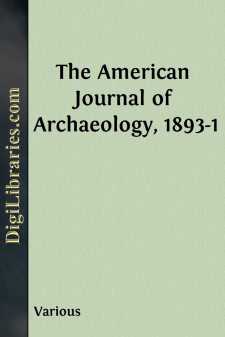Categories
- Antiques & Collectibles 13
- Architecture 36
- Art 48
- Bibles 22
- Biography & Autobiography 813
- Body, Mind & Spirit 142
- Business & Economics 28
- Children's Books 17
- Children's Fiction 14
- Computers 4
- Cooking 94
- Crafts & Hobbies 4
- Drama 346
- Education 46
- Family & Relationships 57
- Fiction 11829
- Games 19
- Gardening 17
- Health & Fitness 34
- History 1377
- House & Home 1
- Humor 147
- Juvenile Fiction 1873
- Juvenile Nonfiction 202
- Language Arts & Disciplines 88
- Law 16
- Literary Collections 686
- Literary Criticism 179
- Mathematics 13
- Medical 41
- Music 40
- Nature 179
- Non-Classifiable 1768
- Performing Arts 7
- Periodicals 1453
- Philosophy 64
- Photography 2
- Poetry 896
- Political Science 203
- Psychology 42
- Reference 154
- Religion 513
- Science 126
- Self-Help 84
- Social Science 81
- Sports & Recreation 34
- Study Aids 3
- Technology & Engineering 59
- Transportation 23
- Travel 463
- True Crime 29
The American Journal of Archaeology, 1893-1
by: Various
Categories:
Description:
Excerpt
THE TEMPLE ON THE ACROPOLIS BURNT BY
THE PERSIANS.
The excavations conducted by the Greek Archæological Society at Athens from 1883 to 1889 have laid bare the entire surface of the Acropolis, and shed an unexpected light upon the early history of Attic art. Many questions which once seemed unanswerable are now definitively answered, and, on the other hand, many new questions have been raised. When, in 1886, Kabbadias and Dörpfeld unearthed the foundations of a great temple close by the southern side of the Erechtheion, all questions concerning the exact site, the ground-plan, and the elevation of the great temple of Athena of the sixth century B.C. were decided once for all. On these points little or nothing can be added to what has been done, and Dörpfeld's results must be accepted as final and certain.
Footote 1:DÖRPFELD, Preliminary Report,Mitth. Ath., X, p. 275; Plans and restorations,Antike Denkmäler, I, pls. 1, 2; Description and discussion,Mitth. Ath., XI, p. 337.The history of the temple presents, however, several questions, some of which seem still undecided. When was the temple built? Was it all built at one time? Was it restored after its destruction by the Persians? Did it continue in use after the erection of the Parthenon? Was it in existence in the days of Pausanias? Did Pausanias mention it in his description of the Acropolis? Conflicting answers to nearly all of these questions have appeared since the discovery of the temple. Only the first question has received one and the same answer from all. The material and the technical execution of the peripteros, entablature, etc., of the temple show conclusively that this part, at least, was erected in the time of Peisistratos. We may therefore accept so much without further discussion. Of the walls of the cella and opisthodomos nothing remains, but the foundations of this part are made of the hard blue limestone of the Acropolis, while the foundations of the outer part are of reddish-gray limestone from the Peiraieus. The foundations of the cella are also less accurately laid than those of the peripteros. These differences lead Dörpfeld to assume that the naos itself (the building contained within the peristyle) existed before the time of Peisistratos, although he does not deny the possibility that builders of one date may have employed different materials and methods, as convenience or economy dictated. Positive proof is not to be hoped for in the absence of the upper walls of the naos, but probability is in favor of Dörpfeld's assumption, that the naos is older than the peristyle, etc. It is further certain, that this temple was called in the sixth century Β.C. το 'ΕκατÃÅμπεδον (see below p. 9). So far, we have the most positive possible evidence--that of the remains of the temple itself and the inscription giving its name. The evidence regarding the subsequent history of the temple is not so simple.
Footnote 2:DÖRPFELD,Mitth. Ath., XI, p. 349.Footnote 3:Mitth. Ath., XI, p....











